The Founder of Bangalore City
The modern metropolitan city of Bangalore was founded by Kempe Gowda I in 1537.
Kempe Gowda also referred to the new town as “Gandu Bhoomi” (“Land of Heroes”).
Visualizing to build a capital city with all basic and essential needs such as water, farming, trading, and protection, etc. at a height of about 900m above sea level in those days was really a great vision of a great ruler – Kempe Gowda, which came true in the form of present Bangalore.
As was wished, Kempe Gowda’s Ban galore has now grown to vast proportions and blossomed into a modern Metropolis in today’s India.
It is now the capital of Karnataka, one of the prominent states in India.
Bangalore has acquired many titles like
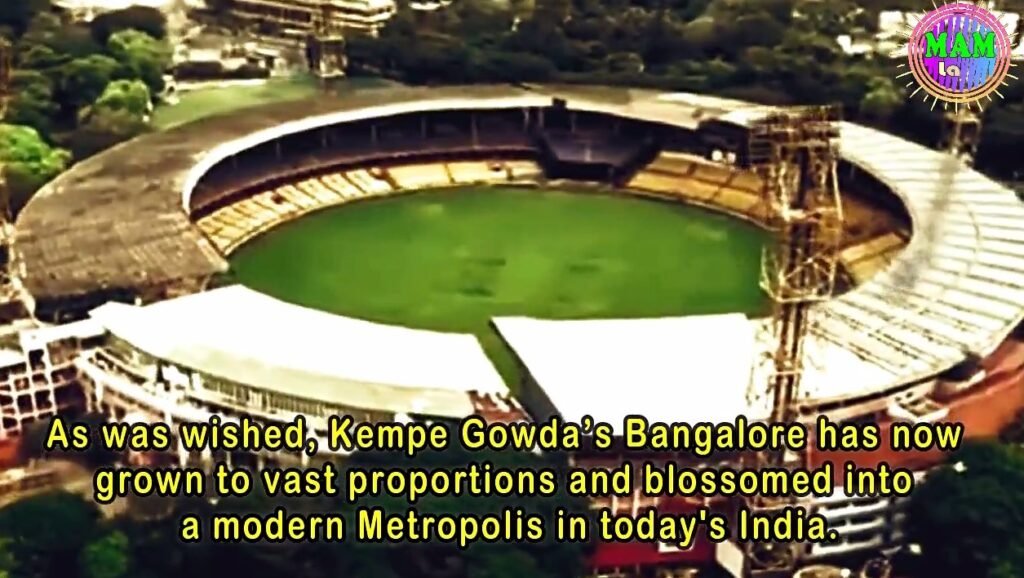
Garden City of India due to large number of trees / greenery, Silicon Valley of India due to large number of IT companies, Electronic City of India, IT capital of India, Science City of India, Space City of India, etc.
On 27 June 2020 commemorating the 511th birth anniversary of Kempe Gowda, the Chief Minister of Karnataka B. S. Yediyurappa performed a Bhoomi Pooja at the Kempegowda International Airport to build a 108-feet tall Kempegowda Statue and a 23-acre Central Park around the statue.
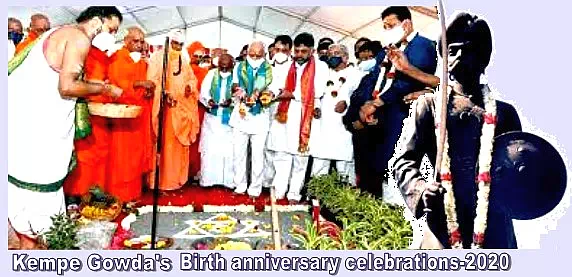
Kempegowda’s birth anniversary celebrations are organized by the state government every year across Karnataka from 27 June 2017, and is seen as Kempegowda day or ′Kempegowda Jayanthi′.
Kempe Gowda belongs to the Vokkaliga Dynasty which ruled parts of Karnataka for about six hundred years (from circa 1200 to 1793) under Vijayanagara Empire.
Kempe Gowda’s full name was Nadaprabhu Hiriya Kempe Gowda.
He was a feudal lord and chieftain under the Vijayanagara Empire.
He ruled over most parts of Karnataka during 16th century.
Kempe Gowda was one of the well-educated and successful rulers of his time. He became the most famous of all the Gowda Chiefs and acquired the name of people friendly ruler by his just and humane administration and by implementing many social reforms.
Kempe Gowda I was born in a village near Yelahanka, a northern suburb in present day Bangalore.
His father Kempananje Gowda ruled Yelahankanadu (Yelahanka), for 70 years.
He succeeded his father around 1513 and ruled for almost 50 years till his death in 1569 AD.
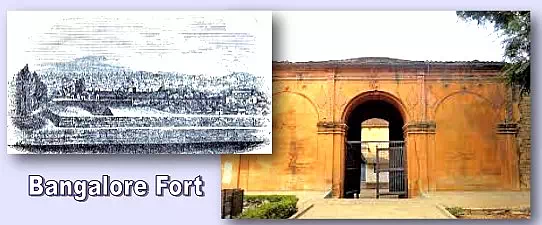
He is also noted for his contribution to building temples and water reservoirs in Bengaluru.
From childhood itself Kempe Gowda showed leadership skills. He was educated at Gurukula for nine years in Aivarukandapura (Aigondapura), a village near Hesaraghatta.
It is said that during a hunting expedition with his Minister Veeranna and Advisor Gidde Gowda, Kempe Gowda visualised building a city that would house a fort, a military cantonment, water tanks, temples, people of all trades and professions to live in it, and provide employment to tradesmen.
He approached the Vijayanagara kings for the requisite permission and laid the foundations for Bangalore Fort in 1532 at the Southern part of Vijayanagar Empire.
He built the city with eight access gates and wide roads with a number of tanks and the settlement spread across. They are now called as Avenue Road, Ulsoor, Yelahanka, K R Market and Malleswaram.
After building Bangalore Fort, and the town in AD 1537, he moved his capital from Yelahanka to the new Bengaluru Pete.
Under Kempe Gowda’s reign, tax collection was just and equitable.
There was a fearless and peaceful working atmosphere for agriculturists and traders to exercise their professions. A watchtower on a granite hillock built by him is still there at Lalbaug.
He also built the Basavanagudi (Bull temple), Ulsoor Someshwara temple and Gavi Gangadhareshwara temple, all of which stand strong to this day.
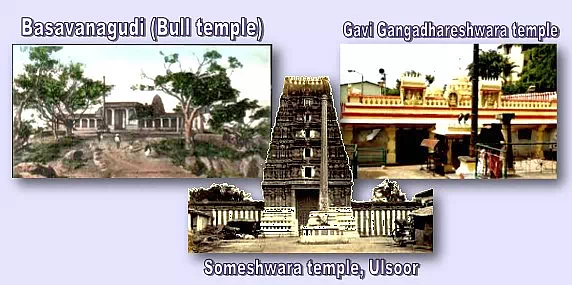
Kempe Gowda also minted coins known as Pagodas in the early 1550s.
The Vijayanagara kings were displease for this act and imprisoned him for five years.
After his release, he was awarded his territories back.
As a mark of gratitude for this, he built the steps leading to the Shivasamudra temple.
Apart from being a kind and just ruler, he was also a social reformer.
He banned many evil social customs that were prevalent during his time.
One of his social reforms was to prohibit the custom of “Bandi Devaru”, an important custom of Morasu Vokkaligas in which the last two fingers of the left hand of the married women being amputated.
He was also famous for his love towards art and learning.
He himself composed a play in Telugu language in the traditional form of Yakshagana titled – ‘Ganga-Gouri Sallapamu. (a debate between Ganga and Gouri), (Ganga and Gouri are the wives of Lord Siva).
According to some literary sources, Bengaluru Kempe Gowda’s elder son Gidde Gowda, took over control after his death.
The lineage of Kempe Gowda lasted for a century in Magadi, where they built many temples, forts and tanks.
A metal statue of Kempe Gowda was posthumously installed in 1609 at Gangadhareshwara temple at Shivagange.
On 7 March 2015 Kempe Gowda’s tomb was accidentally found by Prashanth Marur, a college official turned historian at Kempapura village in Magadi.
It was later confirmed by a group of historians that the tomb was built by Immadi Kempegowda, son of Kempegowda I.
All this was written by Prashanth Marur in Vihayavani newspaper on 3rd September 2015.
As a mark of respect to Kempe Gowda, the Government has named one of the main roads in Bangalore as Kempe Gowda Road.
A metal statue to commemorate the founder of Bangalore has been installed at Corporation Circle in Bangalore in 1964.
Kempegowda Civilian Award is established and is presented annually at ceremony held by BBMP (by Bruhat Bengaluru Mahanagara Palike).
(The Kempegowda Award or Nadaprabhu Kempegowda Award is a civilian award presented annually by Bruhat Bengaluru Mahanagara Palike (BBMP), Bengaluru, Karnataka, India).
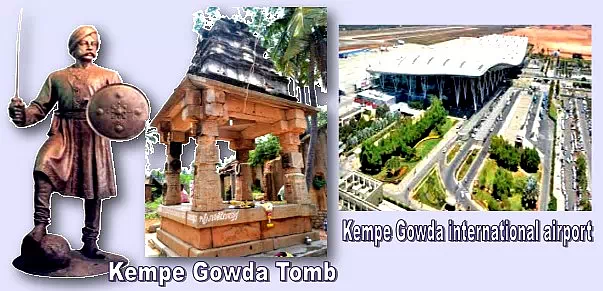
On 14 December 2013, Bengaluru’s main international airport was renamed as Kempegowda International Airport.
To honour him, the Central Bus terminal i.e. Majestic Bus station was named as Kempegowda Bus Station.
The Bangalore Development Authority developed the Nadaprabhu Kempegowda Layout and a park in his honour.
The prominent Majestic metro station (Namma Metro) has been renamed in Kempegowda’s honour.
Educational institutions such as the Kempegowda Institute of Medical Sciences, Kempegowda Institute of Physiotherapy, Kempegowda College of Nursing, and the Kempegowda Residential PU College have been named after Kempegowda.
The Nadaprabhu Kempegowda Convention Center is also located in Bengaluru.


